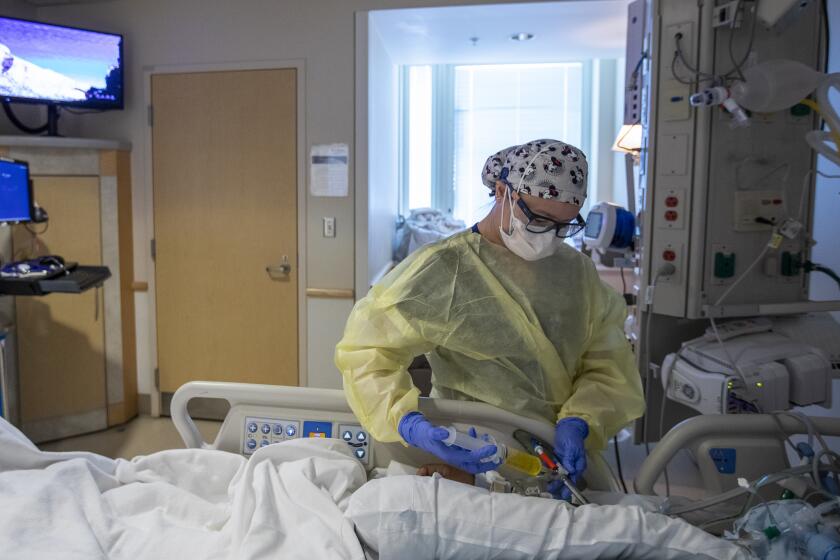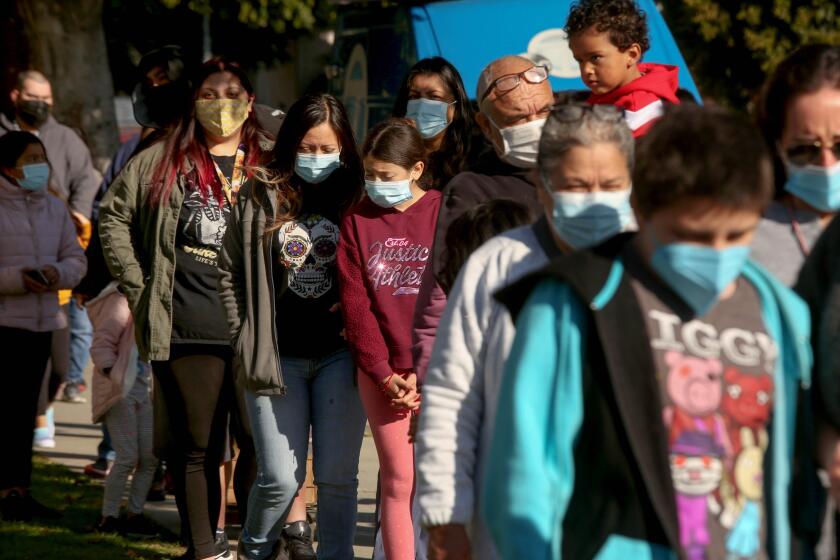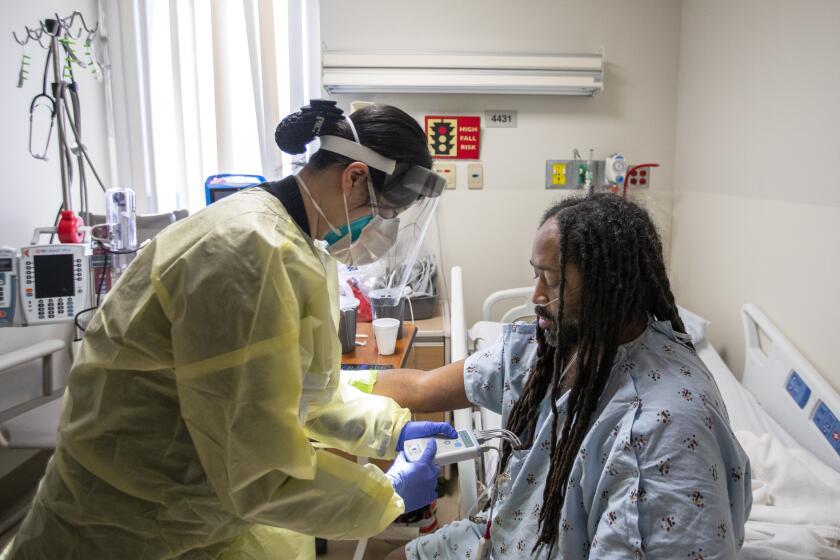California Omicron surge expected to peak within weeks
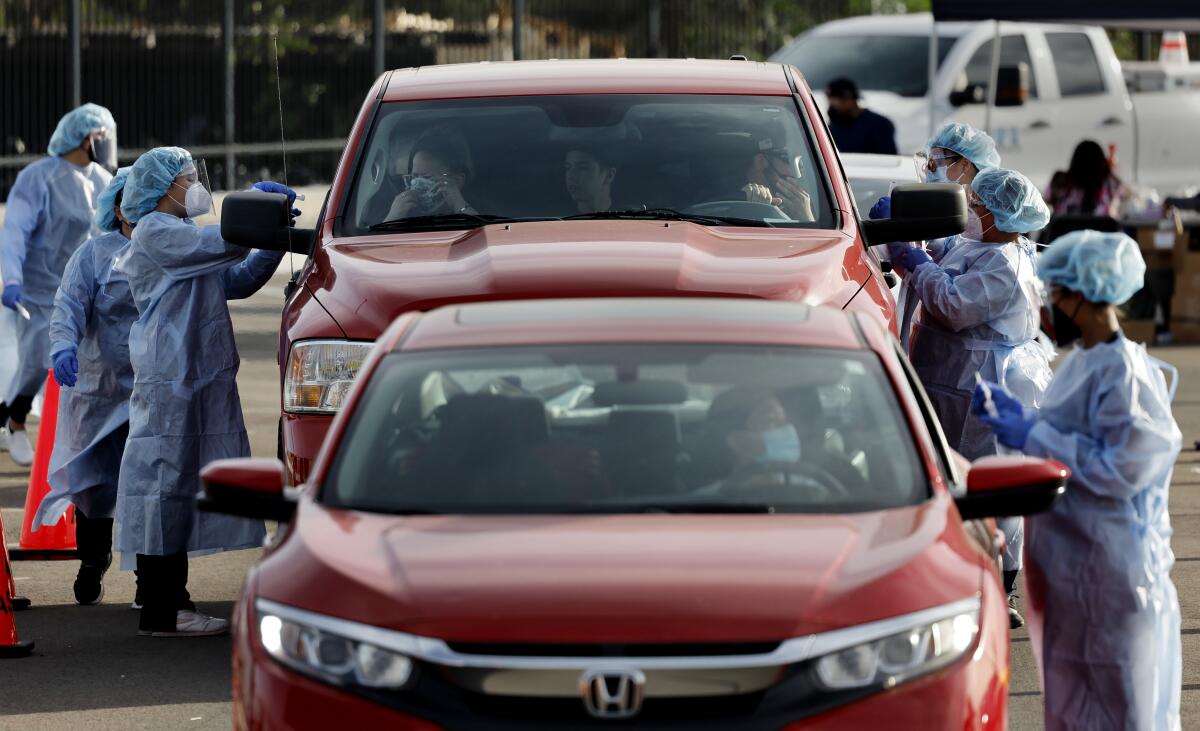
California officials remain highly concerned about how the explosion of coronavirus cases is hitting hospitals, which are already overwhelmed by staffing shortages because of infected workers, forcing surgeries to be canceled and worsening 911 ambulance response times.
But there is also hope that the Omicron wave could begin to flatten in the coming weeks, offering some relief.
Already, parts of the globe that saw Omicron explode are seeing the wave recede or flatten.
New York is seeing potential early signs of having peaked. For the seven-day period that ended Sunday, it was reporting an average of 90,000 coronavirus cases a day. On Wednesday, it was reporting about 71,000 cases a day, according to data compiled by Johns Hopkins University.
The nation’s capital also has seen a flattening. And Britain’s surge may have crested a week ago. For the week ending Jan. 5, Britain was reporting an average of 195,000 cases a day; by Wednesday, it was reporting about 149,000 daily cases.
“We’re hoping that we will follow a similar trend to New York City, Washington, D.C.: Plateau and then start a steep decline within a matter of a couple of weeks, but no way to predict that at this point,” L.A. County Public Health Director Barbara Ferrer said Thursday.
California’s healthcare system is expected to face continued stress in coming weeks as the Omicron variant spawns new waves of coronavirus infection.
“One thing for sure is we are still increasing. We’re not plateauing,” Ferrer said.
The county reported 45,076 new coronavirus cases Thursday, nearly eclipsing the single-day record set Sunday. Over the last week, L.A. County has confirmed almost 288,000 new cases — roughly equivalent to the combined population of Torrance and Pasadena.
Over the last seven days, L.A. County has averaged about 41,000 new cases a day, a pandemic record. That’s more than the prior week’s 25,000 daily cases and last winter’s maximum of 16,000 cases a day.
California also is still reporting record numbers of coronavirus cases. For the seven-day period that ended Wednesday, the state was averaging 114,000 new cases a day. That’s nearly double the prior week’s 63,000 daily cases and far greater than last year’s peak of 46,000.
Northern California’s most populous county, Santa Clara, has recently observed signs of reduced coronavirus levels in feces collected in its sewage.
Early data suggest that high coronavirus levels in sewage peaked last week among samples taken from wastewater treatment plants in San Jose, Palo Alto and Gilroy, and flattened in Sunnyvale, according to data posted on the county’s public health department website. But more days of analysis are needed; it’s also possible the decline could come from random fluctuations in data.
In general, tests are able to reveal an Omicron infection, but enough virus needs to have reproduced and appear at sufficiently high levels in the nose or saliva to be detectable, health officials say.
Still, officials are “cautiously optimistic that that is a sign of things to come,” Michael Balliet, deputy director of the Santa Clara County Public Health Department, said in an interview. Coronavirus levels detected in wastewater have been a reliable hint for trends that emerge earlier than case counts.
Even with the downward trend, Balliet said, there are still very high concentrations of coronavirus in wastewater compared with levels over much of last year.
“We really encourage the community to continue to be diligent in getting their vaccinations, getting their boosters, wearing a mask,” he said.
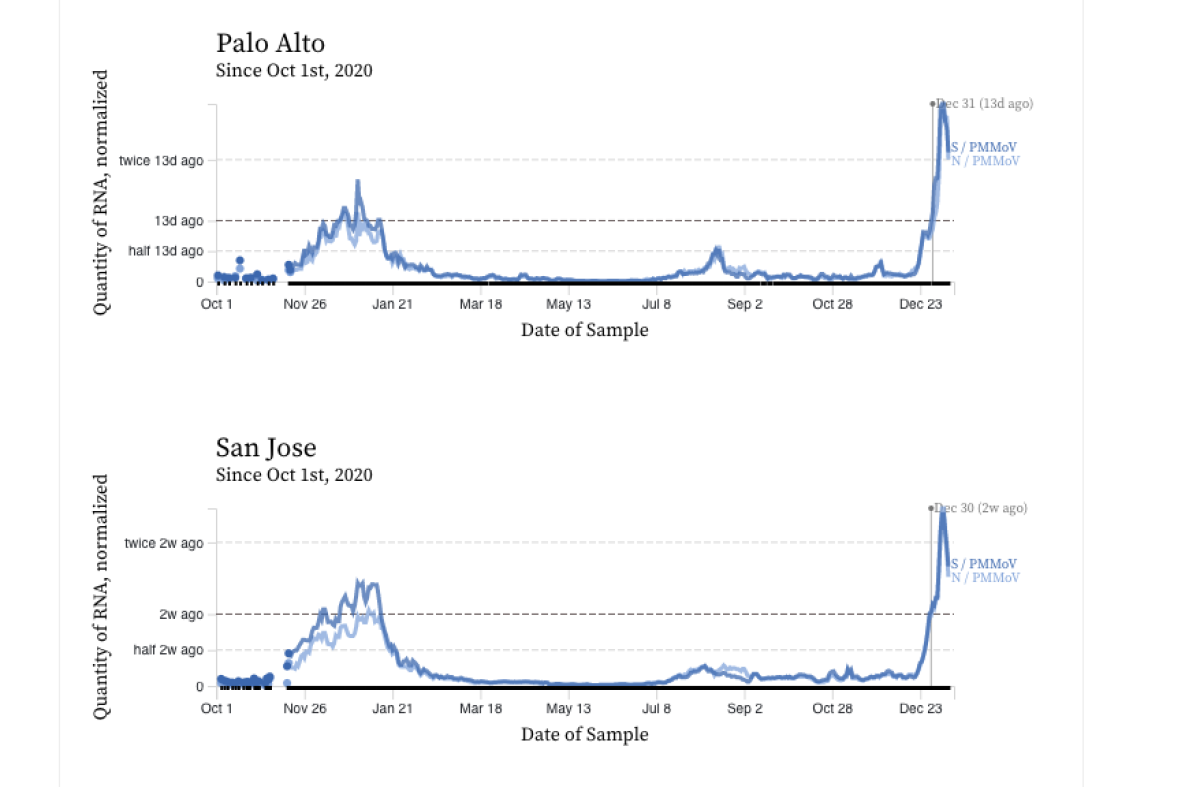
The Los Angeles County Sanitation Districts has not detected a decline in coronavirus levels in its wastewater, according to data published on its website Tuesday.
California’s COVID-19 data models, however, suggest that the transmission rate of the coronavirus may have already peaked. The California COVID Assessment Tool estimates a high mark of Dec. 29, at which time it calculated that every infected person was transmitting the virus to 1.72 others.
The model now estimates the transmission rate is 1.35, which means the virus is still spreading rapidly, but not as fast. The rate needs to be below 1 for the surge to decline.
The University of Washington’s Institute for Health Metrics and Evaluation model projects that the daily number of Californians infected is peaking this week. The model suggests that by mid-February, new infections could be 15% of this week’s levels, about the same as mid-December.
Even once the infection trend reverses, it will still take weeks for the full fury of the Omicron wave to dissipate. Throughout the pandemic, officials have noted that a rise in cases will invariably trigger corresponding increases in COVID-19 hospitalizations and deaths a few weeks later. The institute, for instance, estimates the number of hospitalized coronavirus-positive patients will peak at the end of January.
When it comes to hospitalizations and deaths: “The sad thing is, once we see these increases, they’re likely to continue for a few weeks after cases plateau or begin to decline,” Ferrer said.
The number of coronavirus-positive people in L.A. County’s hospitals is still rising. There were 4,175 on Wednesday, more than quadruple the number on Christmas Day but about half of last winter’s peak.
And while much has been said about Omicron causing less severe illness, the burden on hospitals is still climbing. Part of it has to do with greater demand for non-COVID-19 care this winter, as well as COVID-19 patients who still need hospitalization even if they don’t need treatment in the intensive care unit.
Ferrer said she believed there are still people infected with the Delta variant who have been dying in L.A. County’s hospitals. The county reported 39 COVID-19 deaths Wednesday and 45 on Thursday. The latter is the highest daily fatality figure recorded over the autumn and winter.
Over the last week, the county has averaged 24 reported COVID-19 deaths a day, up from about 14 a month ago.
“Many people are sick for quite a while and many are hospitalized for quite a while before they pass away, so it is likely that most of the deaths we are seeing are still related to Delta, although not entirely,” Ferrer said.
Los Angeles County health officials are urging residents to postpone nonessential gatherings and avoid some activities, especially with people who are unmasked, unvaccinated or at higher risk of severe illness.
The number of people hospitalized for all reasons is also increasing and has reached 15,000 in L.A. County. That’s close to the peak of 16,500 from last winter’s surge, Ferrer said.
COVID-19 patients are also comprising an increasing share of L.A. County’s ICU patients, nearly 25%. That figure was 10% around Christmas. During the summer Delta surge, that number peaked at 20%, and last winter, it maxed out at 70%.
There’s also an increase in the percentage of patients on ventilators who have COVID-19. About 20% of ventilated patients now have COVID-19; that figure was 10% last month. The latest number is the same as the summer surge, and is one-third last winter’s peak.
“This means that Omicron is causing not just an increase in the overall census at hospitals, but it’s also driving increases in the proportion of ICU and ventilated patients,” Ferrer said. “And while, thankfully, this is not at levels that we saw during last winter surge, these numbers do serve as a stark reminder that, for a growing number of people, Omicron is causing severe illness.”
The latest findings indicate that some early data suggesting that Omicron patients faced little or no need for mechanical ventilation may not show a complete picture of what the variant can do as more people get infected.
L.A. County is also readjusting its estimates on the percentage of coronavirus-positive patients who are in the hospital for COVID-19-related reasons compared with those whose infection status is incidental to their hospital stay. Estimates show that nearly 60% of coronavirus-positive patients who are hospitalized are needing care for COVID-19. Previously, it was estimated that about half of coronavirus-positive patients needed care for COVID-19.
The reason for the revision, Ferrer said, is because the data are delivered to scientists at the time a patient is discharged. And patients who need treatment for COVID-19 stay longer in the hospital than coronavirus-positive patients whose infections are incidental to the reason for their hospital stay.
Officials and experts in California continue to stress that with Omicron spreading so fast, the public should take precautions against getting infected.
Even though an Omicron infection results, on average, in less likelihood of hospitalization, California is still estimating that about 4.5% of residents will require a hospital stay with this strain of the virus. And, officials warn, it’s not clear how survivors will fare with long COVID, which can result in illness that lasts for months or longer, nor how likely child survivors of Omicron will be to face multisystem inflammatory syndrome, or MIS-C, a rare but serious complication that can be deadly.
“Anyone who tells you that, for certain, you can assure someone they won’t have long-term [consequences] from having an infection; anyone who tells you, for sure, they know that this variant will give you immunity that will last forever and so, therefore, you should go out and get infected — they don’t know,” said Dr. Kirsten Bibbins-Domingo, chair of the UC San Francisco Department of Epidemiology and Biostatistics. “Because the best virologists, the best epidemiologists, the best physicians don’t know and disagree on these various topics.”
L.A. County has identified the 20 most hard-hit emergency rooms, and county employees have been dispatched to the top 10 — all privately run hospitals.
Bibbins-Domingo said that she’s still living her life and leaving her home but that she’s taking precautions to avoid getting infected.
On Monday, Los Angeles County health officials urged residents to postpone nonessential gatherings and avoid some activities — especially those with people who are unmasked, unvaccinated or at higher risk of severe COVID-19 illness.
The ask comes just ahead of the Martin Luther King Jr. Day holiday weekend. The Lunar New Year is also right around the corner, on Feb. 1.
The county’s rules regarding events like the Super Bowl remain unchanged. Large outdoor events may proceed with attendees age 5 and older required to be either fully vaccinated or show a recent negative coronavirus test and with masks being worn by everyone age 2 and older except when actively eating or drinking.
Officials are also urging people to upgrade their masks. The most protective are N95, KN95 and KF94, and surgical masks are better than loose cloth masks alone. A surgical mask, commonly called a blue mask, can be made even better by placing a cloth mask on top of it, which tightens the fit.
“When there’s this much transmission — and it will take a while for transmission to drop really low — people who are at high risk really need to avoid nonessential activities with others,” Ferrer said. “It just doesn’t make sense to go to parties if you’re an older person, if you’re a person with serious underlying health conditions, if you’ve got any kind of immunity health issues.”
More to Read
Sign up for Essential California
The most important California stories and recommendations in your inbox every morning.
You may occasionally receive promotional content from the Los Angeles Times.
